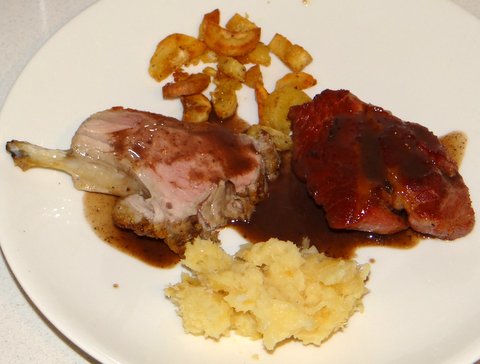
The ‘secondo’ (main dish) for my lamb extravaganza was this: neck of lamb sous-vide, rack of lamb, parsley root puree and roasted chervil root, served with a lamb jus. The recipes for the parsley root and chervil root will follow in my next post, this post will deal with the neck of lamb. The neck is one of the tastiest cuts of lamb, but also one of the toughest because the neck musles are used a lot. It is ideally suited for cooking sous-vide, which will make it melt-in-your-mouth tender while keeping it succulent. For a good crispy crust I both pre- and post-seared it in clarified butter. This dish worked best out of the three with the 1998 red Sancerre.
Make sure to get neck of lamb from a female animal, as males have a strong unpleasant scent that is accentuated by the low and slow cooking. The cooking time of 24 hours is suitable for an actual lamb. If your lamb is a bit older (i.e. really a sheep), you might need more time to get it tender.
Ingredients
1 neck of lamb (about 1 kilogram or 2 lbs)
fresh thyme and rosemary
salt and freshly ground black pepper
clarified butter (or a mixture of butter and olive oil)
To finish the dish
1 rack of lamb (with 8 ribs)
1 glass (100 ml) red wine
concentrated home-made lamb stock
parsley root puree
roasted chervil root
butter
Preparation
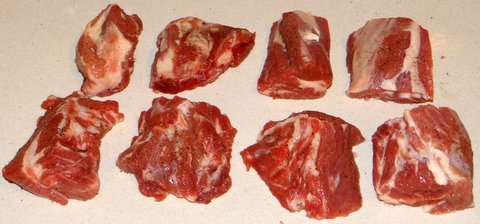
Cut the neck of lamb into serving pieces, trimming away some of the fat on the outside. Season with salt and freshly ground black pepper.
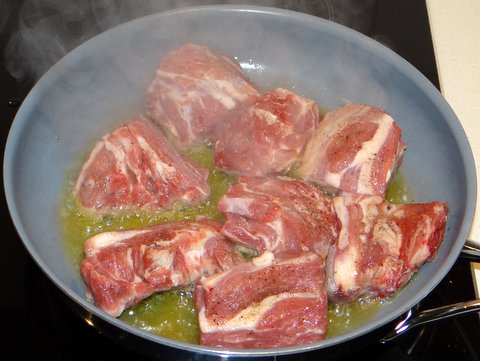
Heat clarified butter (or butter and olive oil) in a frying pan over high heat. Add the pieces of neck.

Brown on all sides over high heat.
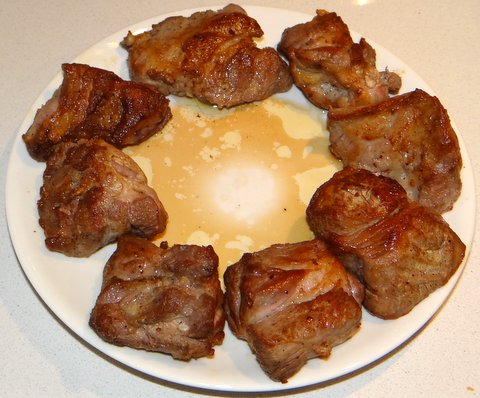
Put the pieces on a plate to cool. If the plate is not completely flat and you put them on the side as shown, the juices will collect in the middle of the dish so you can add them to the sauce later.
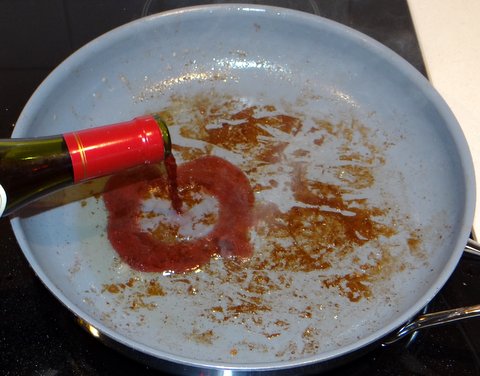
Pour the fat out of the pan and deglaze with some red wine.
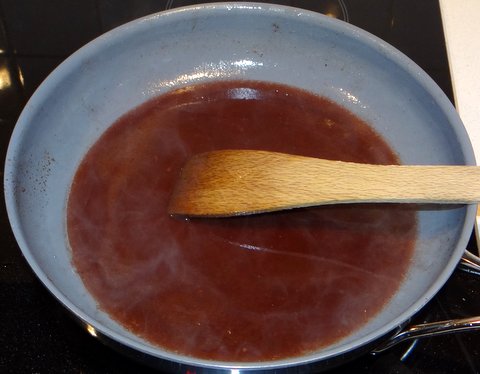
Scrape the tasty bits off the bottom to add all the taste to the sauce. Reduce over medium heat to burn off the alcohol.

Vacuum seal the neck of lamb pieces with plenty of fresh thyme and rosemary.
Cook sous-vide for 24 hours at 57C/135F.
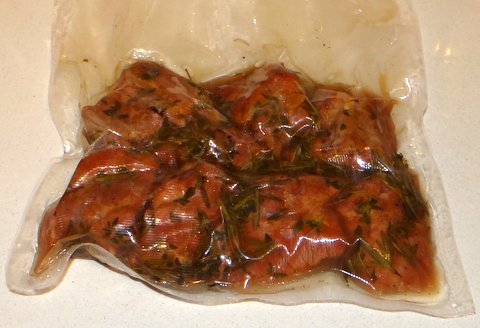
If you like you can use the juices from the sous-vide pouch to add to the sauce as well, just make sure to use my trick to remove the scum that will form.
Let the pieces of lamb cool for 10 minutes or so to prevent overcooking them in the final sear.
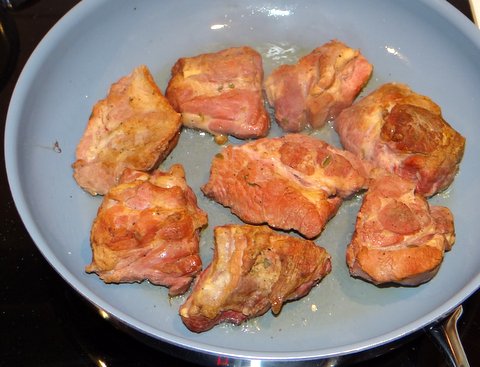
Pat the pieces of lamb dry with paper towels, and brown them again in clarified butter over high heat. This will give them a very nice crispy crust.

I served it with parsley root puree and roasted chervil root (post to follow), a lamb chop from a rack of lamb (cooked in the oven at 160C/325F to a core temperature of 55C/131F), and a lamb jus.
For the lamb jus, I added concentrated lamb stock to the pan that I had deglazed with red wine, I tasted to adjust the seasoning with salt and freshly ground black pepper, and finally I mounted the jus by beating in small pieces of cold butter off the heat.
Wine pairing

I paired this dish with a 1998 Henri Bourgeois red Sancerre “La Bourgeoise”, a pinot noir from old vines made with 1/3 new barriques from a special flint terroir (silex). I included the other bottles that we had the same night (with a group of 8) in the photo to show you the size of the double magnum. The pairing was very good, although the 1996 Corton-Vergennes Grand Cru (a red burgundy) we had when the Sancerre ran out wasn’t bad either 😉

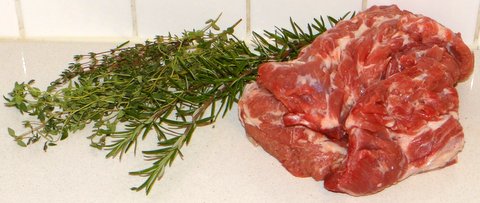

Neck of lamb? that’s not something you find easy…Looks yummy
LikeLike
Thanks for stopping by and leaving a comment 🙂
You can probably only get it at a butcher that butchers by himself, as many necks from lambs that are butchered in mass production are used for shawarma and only the legs and racks are sold to supermarkets.
LikeLike
so depressing not to be able to find these cuts. I have been going crazy looking for duck gizzards for months! its not such a “weird” food (I think). I just started a blog about those less appreciated cuts if you are interested in visiting 🙂 http://cookweirdfood.wordpress.com/
LikeLike
You may be able to find neck of lamb at a halal butcher.
Thanks for the link, I checked it out and thought it was interesting.
LikeLike
Great post. We make lamb’s neck but the typical cute here cut is different (bone-in, like a shank). But we can / will do this…love the texture and flavor of the neck.
LikeLike
Thanks! The bone is great for making stock 🙂
LikeLike
Nice post, Stefan. I eat a fair amount of lamb although I’ve never tried lamb neck before. Most of the time I use neck pieces for stocks and such. I have a Mediterranean market that sells halal lamb in it’s butcher shop. In fact, all meats they sell, including chickens, are halal. They are very particular about their lamb and butcher it to your specification. They supply the Middle Eastern community in Dallas with much of their groceries, especially those who are diet conscious. I will have to give this a try.
LikeLike
Thanks, Richard. With such a good source of lamb and a sous-vide setup you should be able to make something very tasty. The halal lamb here is often from older animals that require a longer cooking time of 2 days instead of 1. The easy way would be to test after the first day and then see if it’s tender or not.
LikeLike
Like Richard before me, I’ve not seen, nor tried, lamb neck before. Lamb neck bones are relatively common, though, and it might simply be a matter of asking the butcher for some. I’ve got time to find out. I’ve no sous-vide equipment and have no plans to purchase any in the future. I guess I’ll just have to sous-vide vicariously through your experiences. 🙂
LikeLike
Thanks, Richard.
You can also prepare the neck of lamb in the oven. With the oven at a low setting (80C/160F or so), a digital thermometer with a probe to monitor the core temperature, and basting the meat now and then, you should be able to get a pretty similar result.
LikeLike
I was browsing the Sunday magazines at the weekend and I came across a domestic sous vide machine at what looked like a pretty expensive €350. If anything could get me to open my wallet, it’s this. It looks fantastic. The magnum must have helped the proceedings too.
Best,
Conor
LikeLike
Thanks, Conor. 350 is not bad at all. There is a risk in visiting and playing with the SV machine (not to mention tasting what comes out of it)… 😉
LikeLike
great post. I have yet to cook anything sous vide for longer than 10 hours, I always worry that the IC will overheat and the water will all evaporate… i know… just cover the pot and it should all be well.
LikeLike
You should indeed cover the pot in such a way that the water that evaporates will condensate on the cover and flow back into the pot. I’ve cooked sous-vide for 72-hour periods dozens of times and have never had any problems. Such low and slow cooking is the best of sous-vide as it can turn tough cuts into something very tender and flavorsome, so please give it a try!
LikeLike
Agree, I love cooking Sous vide, I will try longer cooking times, maybe i’ll have the IC near my bed just in case, so I can sleep at night hahaha. I do have one question, and this is something I’ve been meaning to test. When vacuum sealing food, i can adjust how much air is removed from the bag by setting a longer vacuum cycle… i always wonder if tighter vacuum makes food lose more water when cooking, and a less tight vacuum would help retain water inside the food making it a better approach? I’ve actually consider avoid vacuum sealing all together and just submerge the protein in fat inside the bag, confit style. What do you think?
LikeLike
What you could to to calm your nerves is to measure how much water evaporates in the 10 hours you have experience with it, covering the water bath properly of course. You can then extrapolate how much water will be lost in 24, 48 or 72. It is pretty safe assumption that once the water bath has reached its target temperature the evaporation will be more or less constant (depending only a bit on the humidity of the kitchen).
I think the tighter vacuum will wreak its havoc right at the beginning, i.e. you will suck out the juices when you are vacuum sealing. You can actually see this happening, especially if you pre-sear meat and then seal it when it’s still warm.
The main reason for vacuum sealing in 99% of sous-vide preparations is to make sure that the pouch won’t float because of trapped air. I think you will find that you won’t have this problem without having a very tight vacuum.
Adding some fat to obtain confit style is a good idea, but if you don’t get rid of the air then the pouch will float and the protein will not be cooked evenly.
Another reason for not creating too tight a vacuum is that at such low pressure the water in the protein will actually boil when you vacuum seal it (as the boiling point drops if the pressure drops). This boiling has unwanted effects, even if it does not actually ‘cook’ the food at such a low temperature.
Hope this helps!
LikeLike
Super useful info Stefan, thanks again! I want to do a post for this very subject of vacuum sealing at different settings. Probably using a lean protein, those tend to dry out pretty fast, like a chicken breast.
LikeLike
My hunch is that the temperature at which you will cook the chicken breast sous-vide will make a bigger difference in dryness than the vacuum setting. Looking forward to your post!
LikeLike
agreed, but if time and temperature remain constant between the differently vacuum packaged breasts in my test, then I could determine the best seal setting. Say 1h at 145f for all 3 cases.
LikeLike
Agreed
LikeLike